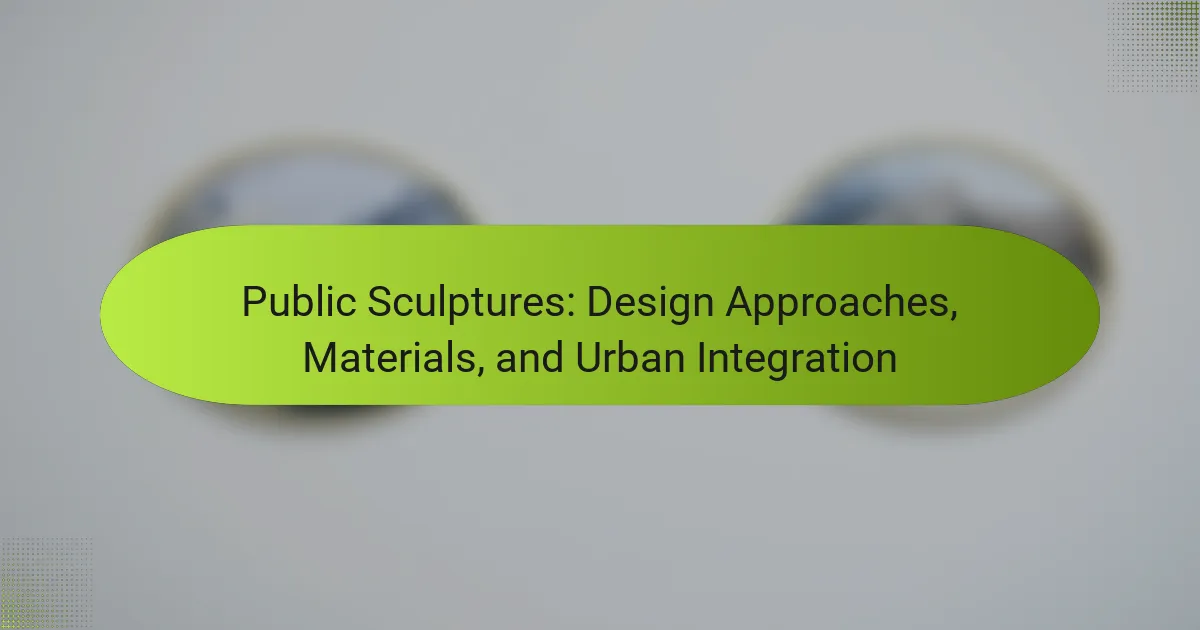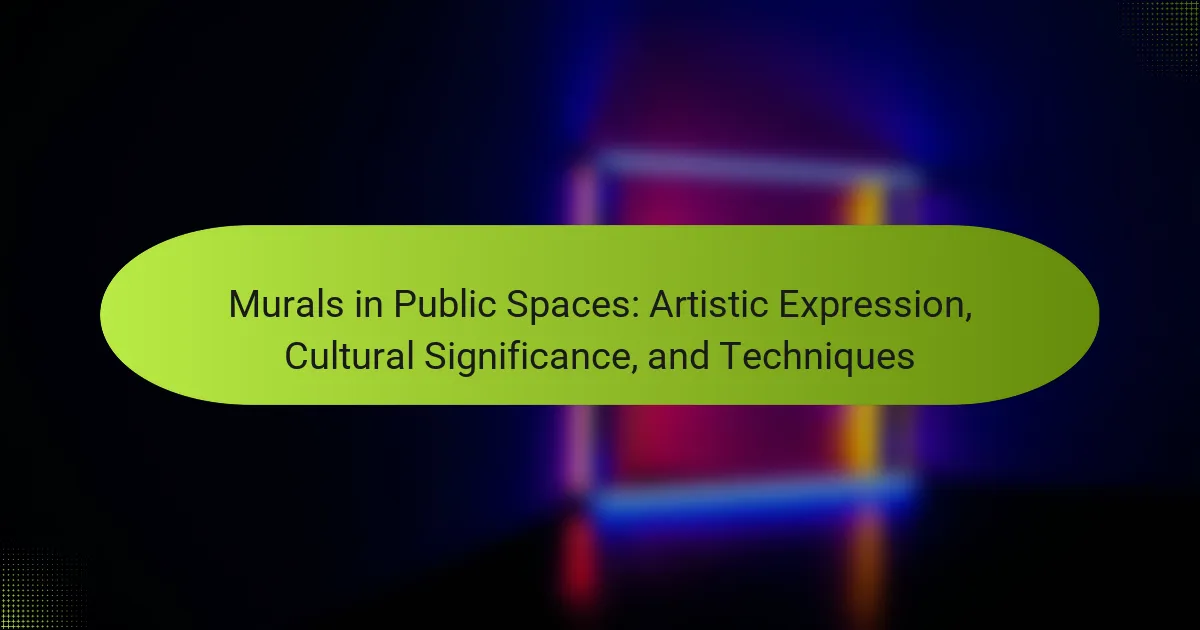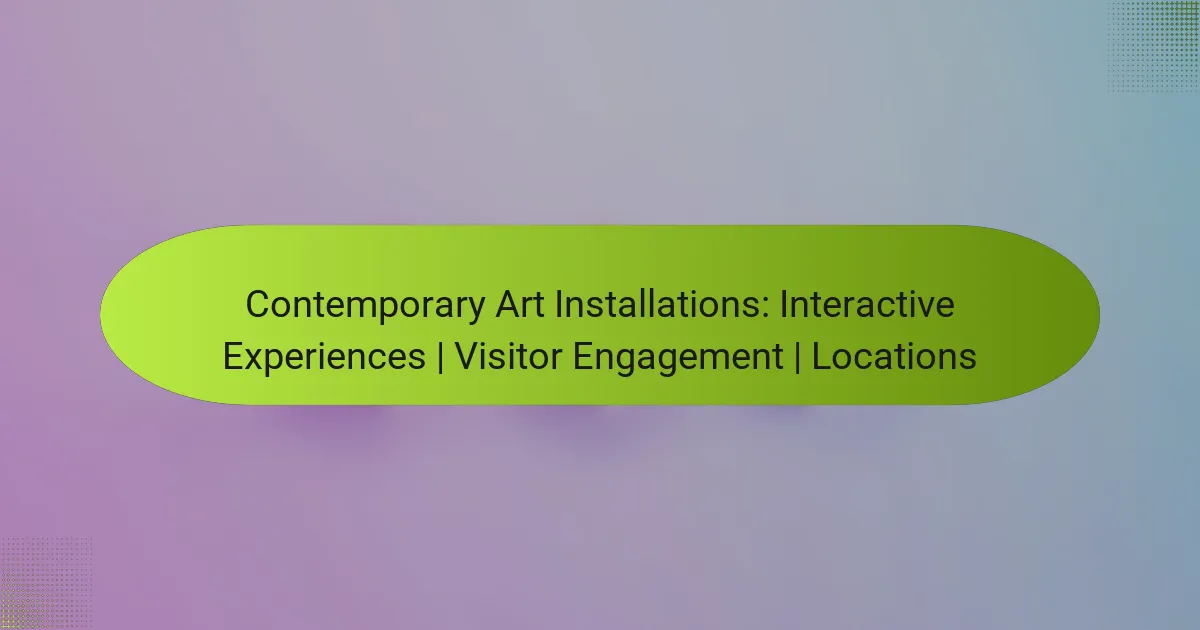Environmental art plays a crucial role in promoting sustainability, enhancing urban aesthetics, and fostering community engagement. Key themes include ecological awareness, urban revitalization, and collaboration among local residents. Notable projects like the High Line in New York and the 606 in Chicago demonstrate how art can transform neglected spaces into vibrant environments. By utilizing recycled materials and encouraging community participation, environmental art not only beautifies urban landscapes but also addresses pressing ecological issues.

What are the key sustainability themes in environmental art?
Key sustainability themes in environmental art include ecological awareness, community engagement, and urban revitalization. These themes promote environmental stewardship and foster connections between art and nature. Ecological awareness emphasizes the impact of human activity on ecosystems, encouraging artists to create works that reflect environmental challenges. Community engagement involves collaborative projects that unite local residents, enhancing social ties and inspiring action toward sustainability. Urban revitalization focuses on transforming neglected spaces into vibrant, sustainable environments through artistic interventions, improving both aesthetics and ecological health.
How do these themes influence urban spaces?
Environmental art significantly influences urban spaces by integrating sustainability themes and fostering community involvement. This art form enhances public awareness of environmental issues, promotes ecological practices, and encourages local engagement.
Sustainable art installations often utilize recycled materials, reducing waste while beautifying urban areas. These projects can transform neglected spaces into vibrant community hubs, enhancing social interaction and environmental consciousness.
For example, community gardens or murals made from repurposed materials not only beautify neighborhoods but also serve educational purposes. They highlight the importance of sustainability and inspire residents to take action.
As a result, environmental art becomes a catalyst for positive change, encouraging sustainable practices and strengthening community bonds in urban settings.
Why is community involvement crucial in environmental art projects?
Community involvement is essential in environmental art projects because it fosters collaboration, enhances local relevance, and promotes sustainability. Engaging community members ensures that the art reflects their values and concerns, leading to more impactful and lasting changes. Collaborative efforts can also mobilize resources and skills, creating a sense of ownership and commitment to environmental issues. Furthermore, community participation can educate and inspire individuals, raising awareness about sustainability themes and practices. As a result, these projects not only beautify urban spaces but also strengthen community ties and encourage collective action towards environmental stewardship.
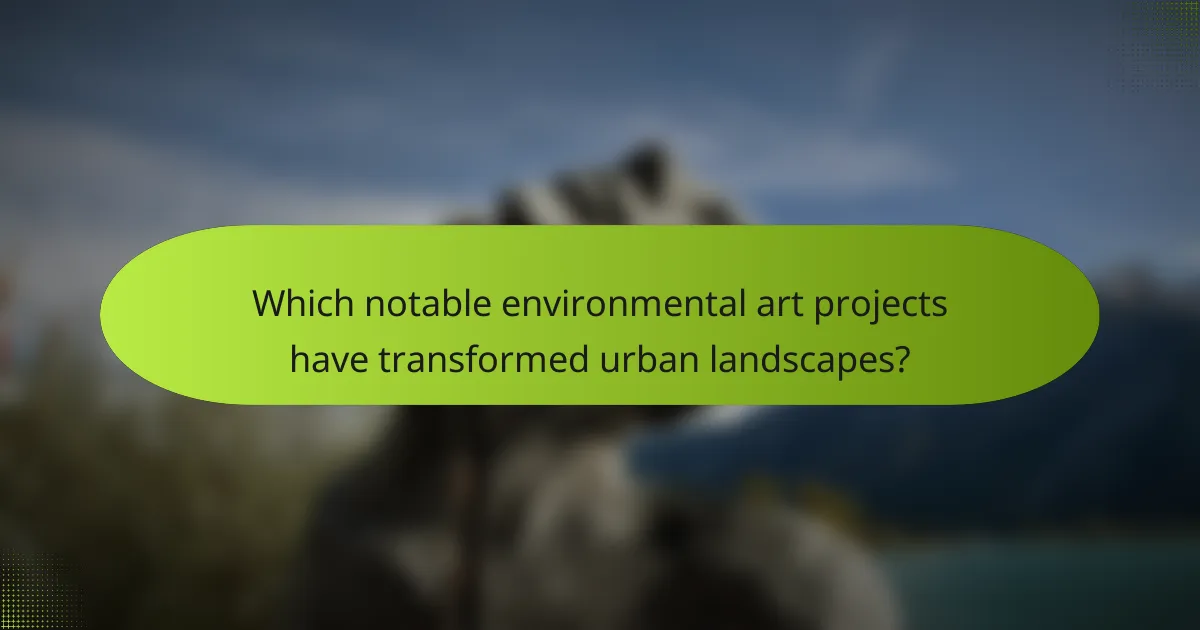
Which notable environmental art projects have transformed urban landscapes?
Notable environmental art projects have significantly transformed urban landscapes through innovative designs and community engagement. Projects like the High Line in New York City repurpose abandoned railways into green spaces, enhancing biodiversity and urban aesthetics. Similarly, the 606 in Chicago transforms an old rail line into a recreational trail, fostering community interaction and ecological awareness. Additionally, the Bosco Verticale in Milan showcases vertical forests that improve air quality and urban livability. These projects exemplify how art can drive sustainability and elevate urban environments.
What role do local artists play in these transformations?
Local artists significantly contribute to environmental transformations by enhancing public awareness and engagement in sustainability. Their artwork often reflects themes of nature and community, fostering a sense of responsibility towards the environment. Through collaborative projects, they unify diverse community members, promoting dialogue on ecological issues. This involvement not only beautifies urban spaces but also inspires collective action for sustainable practices.
How do cultural contexts shape the perception of environmental art?
Cultural contexts significantly influence how environmental art is perceived. Different societies prioritize sustainability themes uniquely, impacting community involvement and the interpretation of urban spaces.
In some cultures, environmental art serves as a tool for activism, emphasizing ecological messages. For example, indigenous communities often incorporate traditional practices into their art, fostering a deep connection to the land. In contrast, urban settings may focus on aesthetic and functional aspects, blending art with public spaces to engage diverse audiences.
Community involvement varies widely across cultures. In collectivist societies, art projects often involve collaboration, enhancing a sense of ownership and responsibility towards the environment. Conversely, in individualistic cultures, artists may prioritize personal expression, leading to varied interpretations of environmental themes.
The perception of environmental art is also shaped by historical context. Regions with a strong history of environmental activism may embrace art as a means of social change, while others may view it primarily as decorative or promotional.
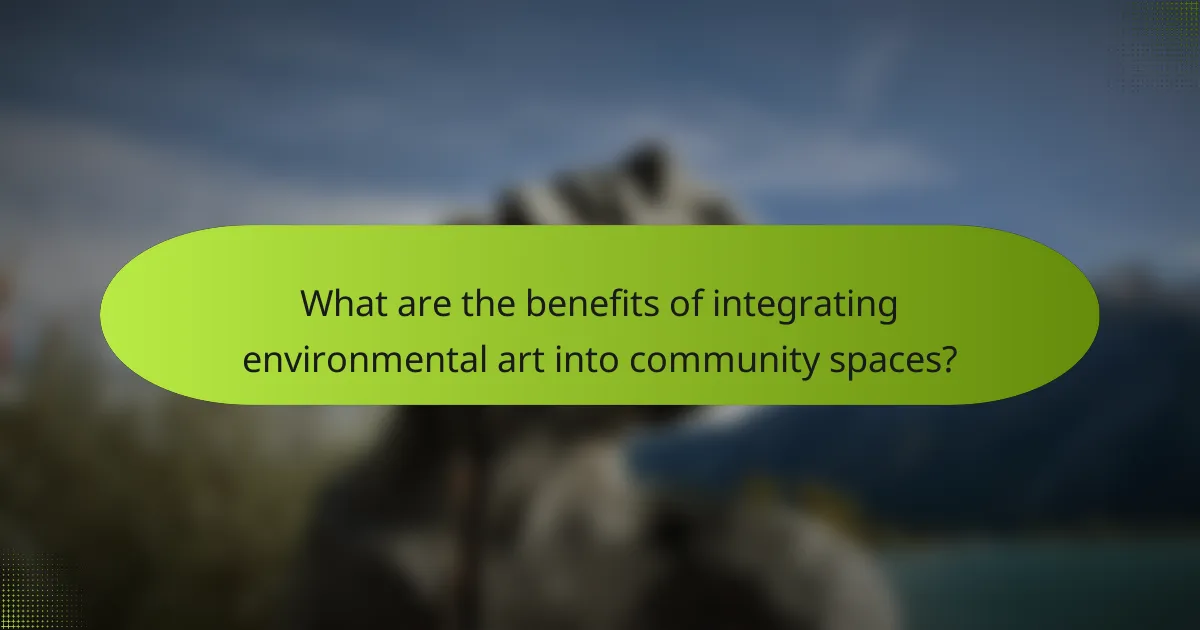
What are the benefits of integrating environmental art into community spaces?
Integrating environmental art into community spaces promotes sustainability, enhances urban aesthetics, and fosters community engagement. These benefits create vibrant, inclusive environments that encourage social interaction and environmental awareness.
Environmental art often utilizes recycled materials, reducing waste and promoting sustainability. This practice not only beautifies urban landscapes but also educates the public about ecological issues. For instance, installations can highlight local biodiversity or the impact of climate change.
Moreover, these art pieces can serve as focal points for community involvement. They encourage collaboration among local artists, residents, and organizations, strengthening community bonds. As a result, residents feel a greater sense of ownership and pride in their surroundings.
Lastly, environmental art can attract tourism and stimulate local economies. Unique installations draw visitors, benefiting local businesses and creating opportunities for cultural events. This economic boost further supports community development and sustainability initiatives.
How does environmental art promote social cohesion?
Environmental art fosters social cohesion by engaging communities in shared projects and promoting dialogue. It transforms urban spaces into collaborative environments, encouraging participation and connection among residents. Projects often reflect local culture and history, enhancing a sense of belonging. For example, community gardens and murals serve as focal points for social interaction. Studies show that such initiatives can improve community ties and reduce social isolation.
What impact does environmental art have on local economies?
Environmental art positively impacts local economies by attracting tourism, enhancing community engagement, and increasing property values. Public installations create vibrant urban spaces that draw visitors, leading to higher sales for local businesses. For instance, cities with notable environmental art projects report a boost in foot traffic, which benefits restaurants and shops. Moreover, community involvement in art initiatives fosters local pride and encourages investment in surrounding areas, further stimulating economic growth.
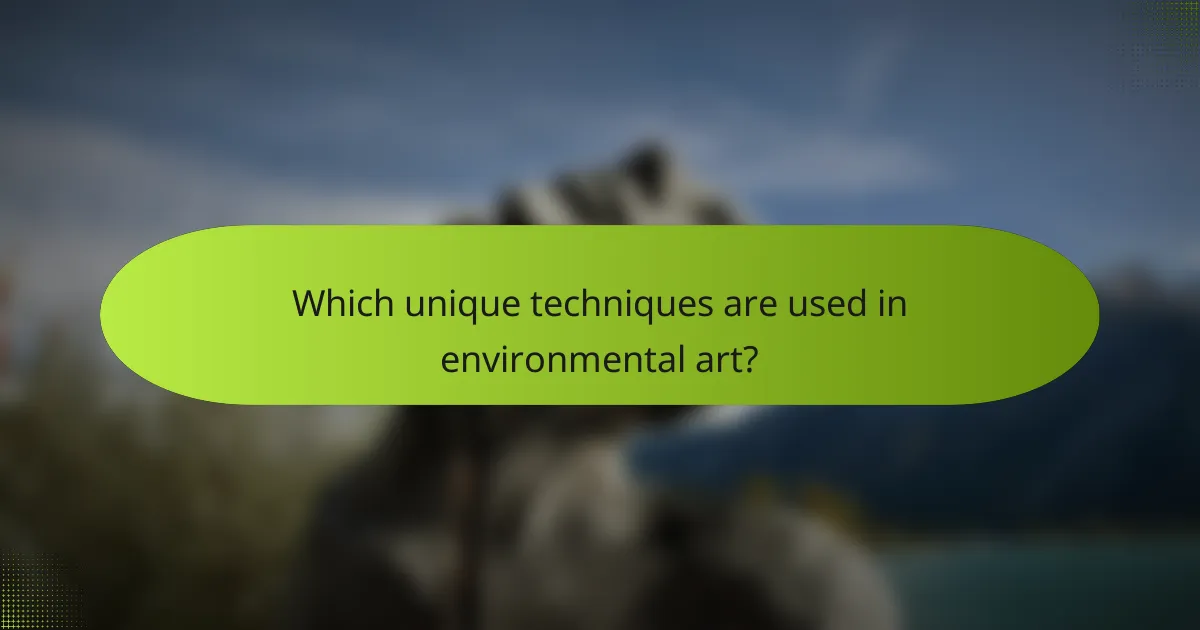
Which unique techniques are used in environmental art?
Environmental art employs unique techniques like site-specific installations, community engagement projects, and the use of natural materials. These methods highlight sustainability themes and foster connections within urban spaces.
Site-specific installations adapt to their environment, enhancing local landscapes and promoting ecological awareness. Community engagement projects invite participation, creating a sense of ownership and responsibility among residents. The use of natural materials, such as soil, plants, and recycled objects, emphasizes a commitment to sustainability while reflecting the local ecosystem.
These techniques not only beautify urban areas but also encourage dialogue about environmental issues and the importance of preserving natural resources.
How do these techniques address local environmental issues?
Environmental art techniques effectively address local environmental issues by fostering community awareness and engagement. These artworks often highlight specific environmental challenges, such as pollution or habitat loss, prompting discussions and actions among residents.
Through interactive installations, artists encourage participation, allowing community members to express their concerns and ideas. For example, murals depicting local wildlife can inspire conservation efforts, while sculptures made from recycled materials promote sustainability.
Additionally, these projects often collaborate with local organizations, enhancing their impact. By integrating art into urban spaces, they transform neglected areas into vibrant hubs of community activity, reinforcing the connection between art, environment, and social responsibility.
What materials are commonly utilized in environmental art installations?
Environmental art installations commonly utilize natural materials, recycled objects, and sustainable resources. Natural materials include wood, stone, and plant life, which enhance ecological themes. Recycled objects, such as plastic and metal, promote sustainability by repurposing waste. Sustainable resources like bamboo and reclaimed materials offer unique attributes that align with environmental consciousness. These choices foster community involvement by encouraging local participation in the creation process.
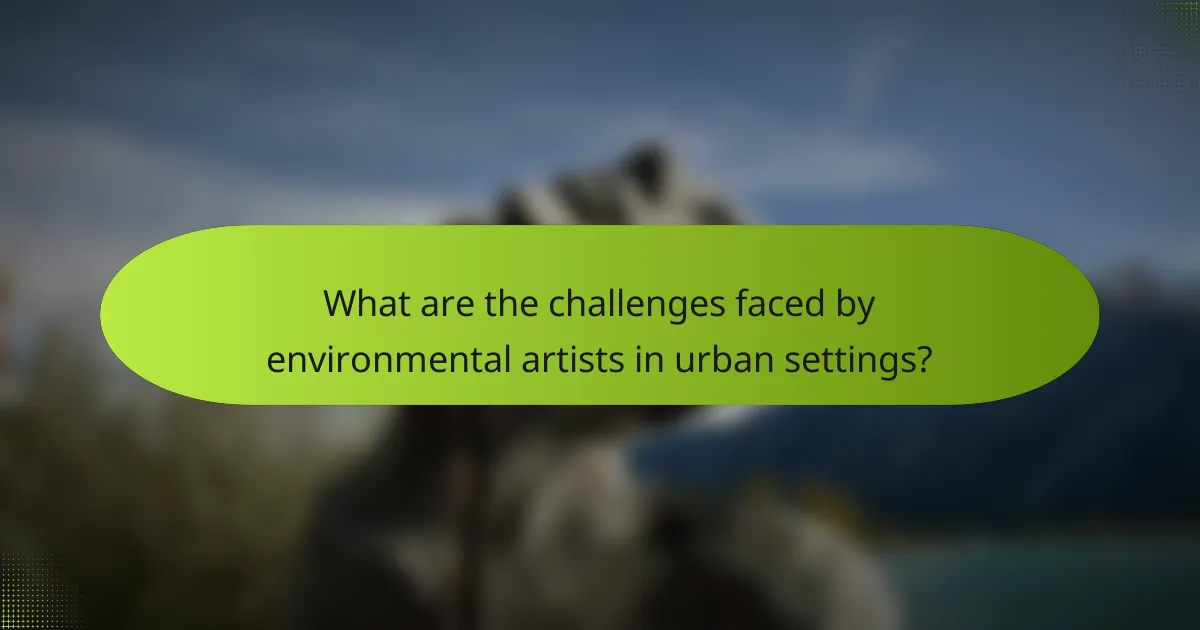
What are the challenges faced by environmental artists in urban settings?
Environmental artists in urban settings face several challenges. Limited funding restricts project scope and materials. Urban regulations often hinder installation processes, complicating site selection. Community engagement can be inconsistent, affecting collaboration. Additionally, environmental degradation impacts the feasibility of sustainable practices. Lastly, public perception may undervalue the importance of art in ecological discourse.
How do funding and resources affect project viability?
Funding and resources significantly influence the viability of environmental art projects. Adequate financial backing ensures access to materials, skilled labor, and community engagement, which are essential for successful execution.
Projects with limited funding often face constraints that hinder their ability to address sustainability themes effectively. For instance, a lack of resources can lead to the use of lower-quality materials, impacting the project’s longevity and aesthetic appeal.
Community involvement is crucial for garnering support and fostering a sense of ownership. Projects that secure funding for outreach initiatives can better engage local populations, ensuring that the art resonates with the community’s values and needs.
In summary, the interplay of funding and resources shapes the potential for environmental art to thrive in urban spaces, making it vital for project planners to prioritize these elements.
What are the common misconceptions about environmental art?
Common misconceptions about environmental art include the belief that it is solely about aesthetics, that it lacks a strong community focus, and that it does not engage with urban spaces. Many think environmental art is only for galleries, ignoring its role in public spaces. Some believe it does not contribute to sustainability, overlooking its potential to raise awareness and inspire action. Others assume it is a niche interest, while in reality, it often fosters community involvement and dialogue on pressing environmental issues.
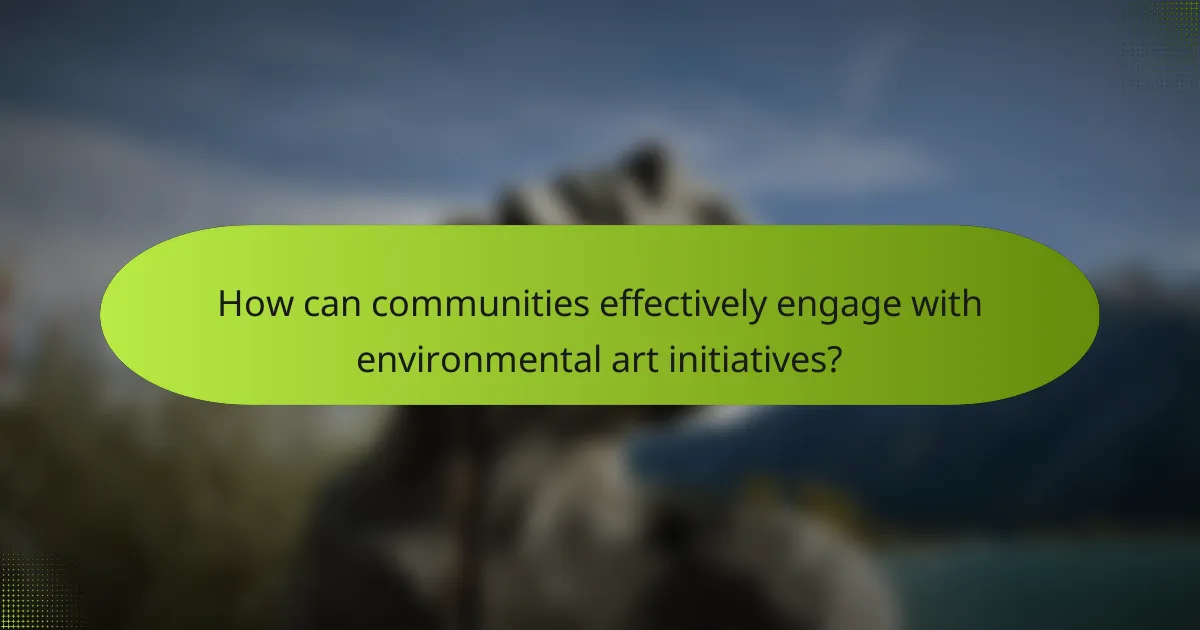
How can communities effectively engage with environmental art initiatives?
Communities can effectively engage with environmental art initiatives by fostering collaboration, promoting awareness, and encouraging participation. Collaborative projects unite artists, residents, and local organizations, enhancing community identity. Awareness campaigns highlight the importance of sustainability themes, creating a shared vision. Participation in workshops and events empowers residents, allowing them to contribute creatively and learn about environmental issues. Engaging diverse groups ensures that unique perspectives shape the initiatives, enriching urban spaces with meaningful art.
What strategies can be employed to foster participation?
To foster participation in environmental art initiatives, engage the community through collaborative projects, workshops, and public exhibitions. These strategies promote awareness and connection to sustainability themes in urban spaces.
Encouraging local artists to collaborate with community members can create a sense of ownership and pride. Workshops can educate participants on environmental issues while providing hands-on experience in art creation. Public exhibitions can showcase the work and attract wider audiences, increasing community involvement.
Utilizing social media platforms to share progress and gather feedback enhances engagement. Interactive online campaigns can invite community members to contribute ideas or vote on themes, further fostering a sense of inclusion.
Finally, partnering with local organizations can amplify outreach efforts. Collaborations with schools, environmental groups, and businesses can provide resources and broaden participation, ensuring diverse community representation in environmental art projects.
Which organizations support community-driven environmental art projects?
Numerous organizations support community-driven environmental art projects. Notable examples include the National Endowment for the Arts, which funds public art initiatives, and Creative Time, known for large-scale art installations that engage communities. Additionally, local nonprofits often partner with artists to create site-specific works that reflect environmental themes. These collaborations enhance community involvement and promote sustainability through artistic expression.
What best practices can ensure the sustainability of these projects?
Engaging local communities and incorporating sustainable practices are essential for the longevity of environmental art projects. Foster collaboration with local artists and organizations to create relevant themes. Use eco-friendly materials to minimize environmental impact. Ensure ongoing community involvement through workshops and educational programs, which can enhance awareness and appreciation for the art. Regularly assess the project’s impact and adapt strategies based on feedback to maintain relevance and sustainability.
